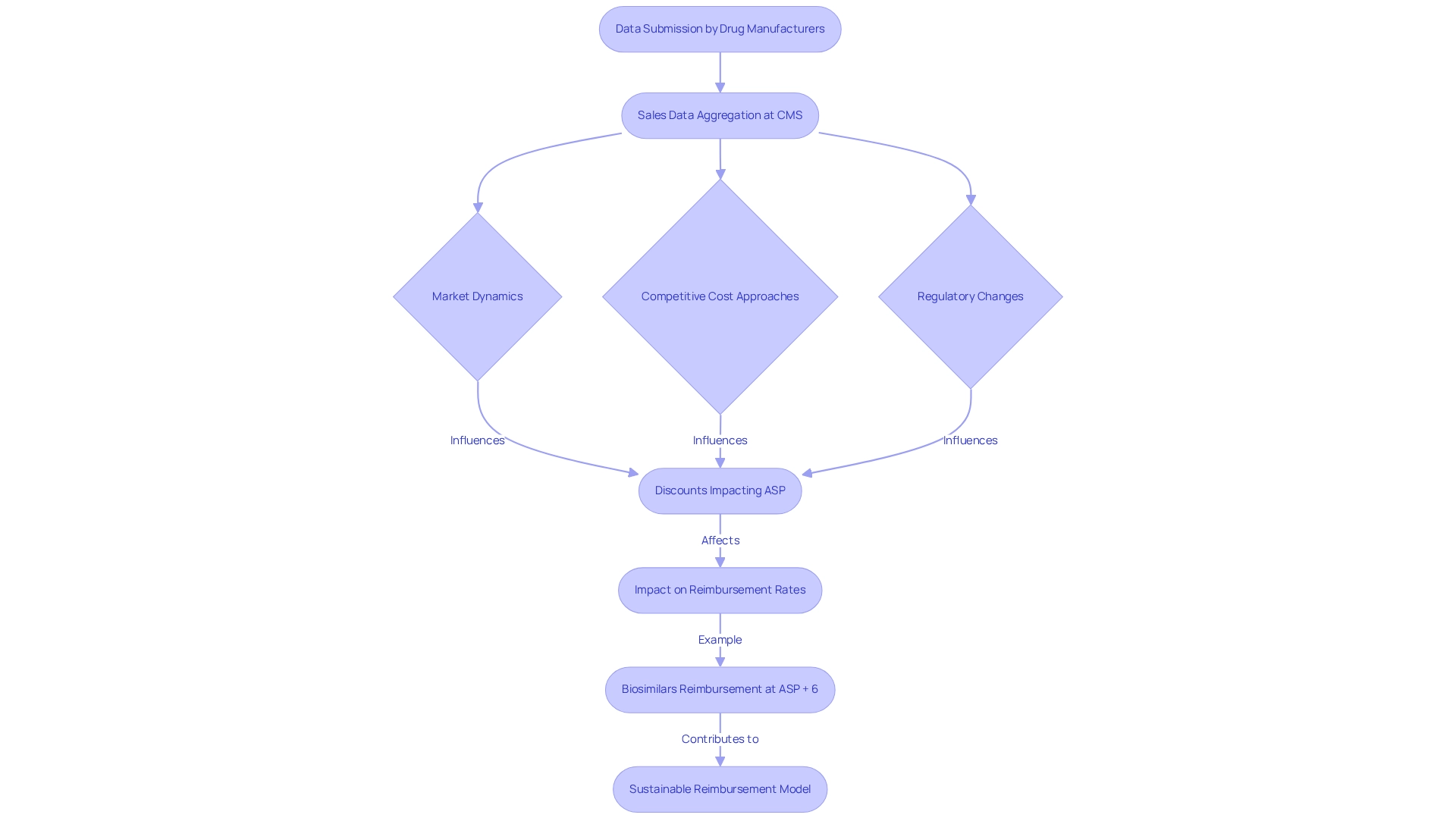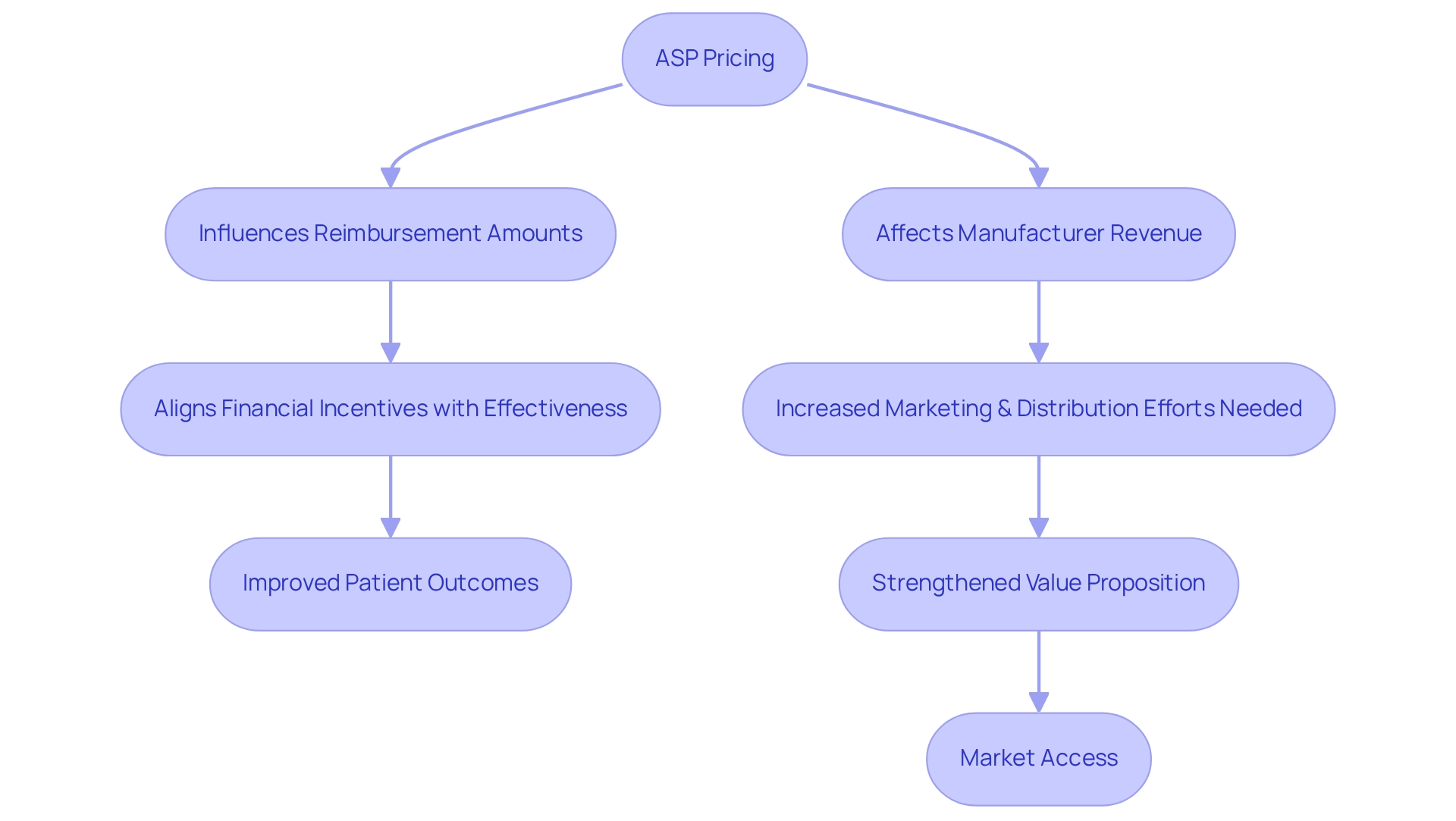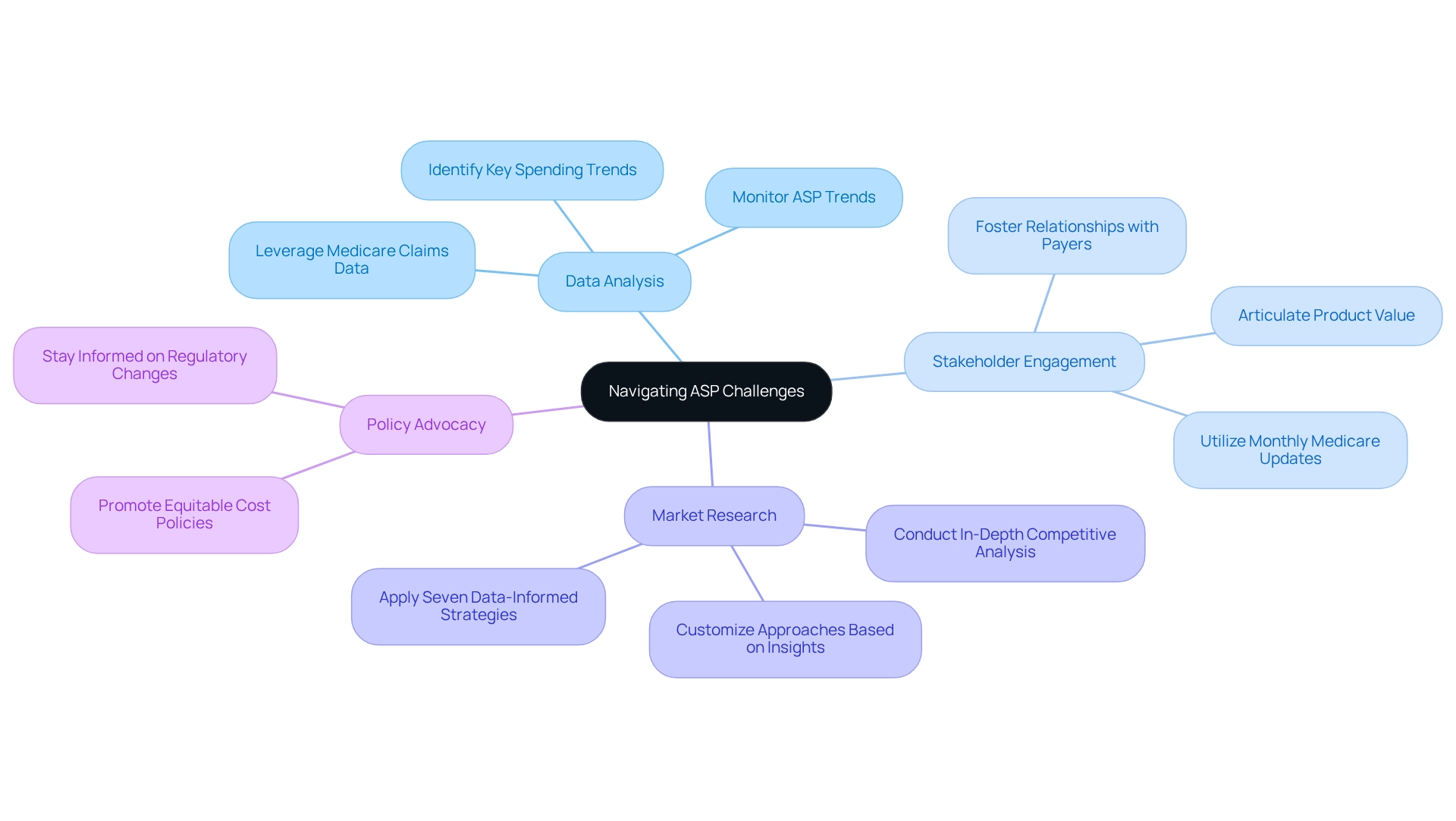Overview
This article emphasizes the critical role of mastering Average Sales Price (ASP) in enhancing pharmaceutical market access strategies. Understanding ASP is essential for pharmaceutical companies, as it directly impacts reimbursement rates under Medicare. Furthermore, the article highlights the necessity of data analysis, stakeholder engagement, and strategic planning to effectively navigate the challenges associated with ASP. By addressing these factors, companies can significantly improve access to medications and optimize their market positioning.
Introduction
In the intricate realm of healthcare reimbursement, the Average Sales Price (ASP) stands out as a crucial metric that influences the financial interplay among pharmaceutical companies, providers, and payers. Defined as the volume-weighted average of a drug’s sales prices after factoring in discounts and rebates, ASP is instrumental in shaping how Medicare compensates healthcare providers for outpatient drugs.
As pharmaceutical companies navigate the complexities of pricing strategies and market access, grasping the nuances of ASP becomes imperative. This article examines the essential components of ASP, detailing its:
- Calculation methodology
- Myriad factors that affect it
- Strategies companies can adopt to enhance their market positioning within a constantly shifting regulatory landscape
By leveraging insights derived from comprehensive Medicare data, stakeholders are empowered to make informed decisions that not only improve patient access to essential therapies but also uphold financial sustainability.
Define Average Sales Price (ASP) and Its Role in Medicare Reimbursement
The Average Sales Price (ASP) represents the volume-weighted average of a manufacturer’s sales prices for a drug, excluding discounts, rebates, and other price concessions. This metric is crucial for Medicare, as it compensates healthcare providers for outpatient medications under Part B, with CMS ASP pricing calculated quarterly and released by the Centers for Medicare & Medicaid Services (CMS). Understanding ASP is vital for pharmaceutical companies, as it directly impacts their reimbursement rates and access strategies. For instance, medications priced at ASP plus 6% can significantly influence a company’s cost strategy and competitive position.
Moreover, the ASP methodology facilitates differential reimbursement advantages for biosimilars, potentially leading to lower costs and improved access to therapies. CareSet’s extensive Medicare data insights empower healthcare stakeholders by delivering actionable information derived from over 62 million beneficiaries and 6 million providers. This data enables a comprehensive understanding of treatment pathways and provider interventions through ICD, NDC, and HCPCS frameworks. A case study titled ‘ASP Methodology and Patient Outcomes’ underscores the necessity of maintaining the ASP methodology to ensure patient access to effective treatments while managing costs within the healthcare system.
As noted by Susan Weidner, an expert in the field, ‘ASP is a market-based tool that can be leveraged in the future to create a sustainable reimbursement model that is beneficial to patients, payers, and providers.’ Looking ahead to June 2025, updates from CMS stress the importance of preserving the integrity of the ASP methodology, thereby reinforcing its role in shaping sustainable reimbursement models that serve the interests of all stakeholders, particularly in the context of CMS ASP pricing.

Explore the Methodology Behind ASP Calculations and Influencing Factors
The Average Sales Price (ASP) is derived from data submitted by drug manufacturers, encompassing sales figures for all National Drug Codes (NDCs) associated with a specific drug. Manufacturers are mandated to report their sales data, which includes any discounts and rebates, to the Centers for Medicare & Medicaid Services (CMS). This data is subsequently aggregated to establish the ASP.
Several elements significantly influence ASP computations, including market dynamics, competitive cost approaches, and regulatory changes. For example, substantial discounts offered by manufacturers to select purchasers can lead to a decrease in the ASP, which directly impacts reimbursement rates. Notably, biosimilars are reimbursed at ASP plus 6%, based on the innovator product’s ASP, illustrating the direct impact of ASP on reimbursement structures. This market-oriented strategy aims to foster a competitive environment for drug costs, as evidenced by the ASP methodology’s success in stabilizing expenses for both brand and generic medications, particularly in oncology therapies.
Understanding these influencing factors is essential for pharmaceutical firms seeking to manage pricing strategies effectively. CareSet’s extensive Medicare data insights empower stakeholders by providing actionable information that enhances comprehension of ASP dynamics and their implications for access strategies. As Susan Weidner aptly stated, “It is imperative to maintain the beneficial attributes of ASP and incorporate them into future reimbursement models.” As the landscape evolves, monitoring these dynamics will be crucial for improving access to services and ensuring sustainable reimbursement models for patients, payers, and providers alike. ASP serves as a market-based tool capable of creating a sustainable reimbursement model, reinforcing its significance in the healthcare landscape.

Analyze the Impact of ASP Pricing on Pharmaceutical Market Access Strategies
Average Sales Price (ASP) costs are pivotal in shaping pharmaceutical market access strategies, as they directly influence the reimbursement amounts that providers receive for medications. A lower ASP can severely impact manufacturers’ revenue, potentially discouraging them from investing in marketing and distribution efforts. Understanding the intricacies of ASP is essential for companies to anticipate cost pressures and adapt their strategies accordingly. For instance, if a drug’s ASP falls short of expectations, manufacturers may need to strengthen their value proposition to payers and providers to maintain market access.
The ASP reimbursement model is crafted to align financial incentives with clinical effectiveness, encouraging providers to choose the most effective therapies for their patients. This alignment has demonstrably enhanced patient outcomes, particularly in oncology, where the ASP methodology has contributed to a decrease in chemotherapy treatments administered within 14 days of a patient’s death. Furthermore, from 2005 to 2017, the ASP model resulted in savings of approximately $132 billion in Part B medicine expenditures for the government and seniors, underscoring its financial importance.
By integrating insights from CareSet’s extensive healthcare data, which includes patient treatment pathways and Medicare claims data, we can further elucidate the impact of ASP costs on drug reimbursement rates. As we approach 2025, the influence of ASP pricing on drug reimbursement rates and access strategies will continue to evolve. Pharmaceutical companies must remain vigilant in analyzing ASP trends to effectively refine their access strategies. Leveraging insights from ASP dynamics alongside CareSet’s data enables stakeholders to enhance their reimbursement and revenue generation approaches, ensuring sustainable access to essential therapies. Identifying effective cost-cutting strategies that have proven successful over the years will further strengthen these efforts.

Implement Strategies to Navigate ASP Challenges and Optimize Market Access
To effectively navigate ASP challenges, pharmaceutical companies should adopt a multifaceted approach that includes cms asp pricing.
Data Analysis: Leverage comprehensive data analytics, such as CareSet’s extensive Medicare claims data, to monitor Average Sales Price (ASP) trends. This allows for proactive modifications to cms asp pricing approaches, which are essential for affecting positioning and decision-making. Notably, the bundling approach accounted for 74% of the variance in improved outcomes, underscoring the effectiveness of data-driven strategies in enhancing results. CareSet’s insights can identify 15% more targets and 250% more patients, providing a significant advantage in comprehending industry dynamics.
Stakeholder Engagement: Foster strong relationships with payers and providers to articulate the value of your products, particularly when addressing cms asp pricing compared to competitors. Involving stakeholders guarantees that the advantages of your offerings are clearly conveyed, improving acceptance in the industry. CareSet’s monthly Medicare updates improve provider engagement by offering novel insights into drug utilization and treatment pathways, which can facilitate these discussions.
Market Research: Conduct in-depth market research to gain insights into the competitive landscape. Comprehending rival costs and positioning can uncover chances for distinction, enabling firms to customize their approaches effectively. Pharmaceutical firms applying seven data-informed approaches to cms asp pricing consistently excel against rivals across various metrics, emphasizing the significance of strategic preparation. CareSet’s analytics solutions dive into over $1.1 trillion in annual claims, spotting key spending trends that can inform these strategies.
Policy Advocacy: Remain vigilant about regulatory changes that may affect ASP calculations. Promoting policies that encourage equitable costs can assist in protecting your industry standing and ensuring sustainable cost strategies.
Executing these strategies not only improves access to the industry but also boosts overall competitiveness in the pharmaceutical field. Companies that utilize robust scenario planning, for instance, have maintained optimal pricing in 68% of market disruption events, showcasing the effectiveness of strategic foresight in pricing models. By prioritizing data analysis and stakeholder engagement, pharmaceutical firms can navigate the complexities of ASP challenges and drive long-term success. To learn more about how CareSet can empower your business with actionable insights, reach out today.

Conclusion
The Average Sales Price (ASP) is a pivotal metric within the healthcare reimbursement landscape, significantly influencing how Medicare compensates healthcare providers for outpatient drugs. Understanding the intricacies of ASP—from its calculation methodology to the various factors that affect it—is essential for pharmaceutical companies seeking to enhance their market access strategies. Insights gleaned from comprehensive Medicare data clarify the dynamics of ASP and empower stakeholders to make informed decisions that improve patient access to necessary therapies.
The impact of ASP pricing extends beyond mere numbers; it shapes the financial viability of pharmaceutical companies and influences provider behavior. By adopting effective strategies such as data analysis, stakeholder engagement, and market research, companies can navigate the challenges associated with ASP. These approaches enable firms to remain competitive and align their pricing strategies with evolving market conditions, ultimately fostering a more sustainable reimbursement model.
As the healthcare landscape continues to evolve, maintaining a keen awareness of ASP trends and methodologies will be crucial for stakeholders across the board. By leveraging data-driven insights and advocating for fair pricing policies, pharmaceutical companies can optimize their market access strategies while contributing to a healthcare system that prioritizes patient outcomes and financial sustainability. Embracing these practices ensures that all parties involved can thrive in an increasingly complex environment, reinforcing the importance of ASP as a tool for both market positioning and patient care.


